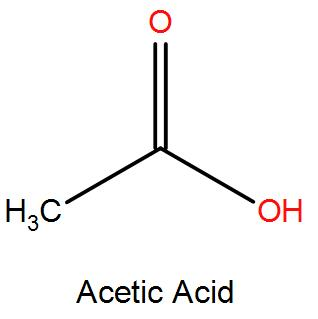
The basicity of acetic acid is:
A.1
B.2
C.3
D.4
Answer
220.5k+ views
Hint: We know that the basicity of an acid is the number of replaceable hydrogen atoms that are present in a molecule of that acid. Hence an acid that contains only one replaceable hydrogen atom in its molecule is known as a monobasic acid and its basicity is 1. Similarly, the acid which contains two replaceable hydrogen atoms in its molecule is called a dibasic acid and its basicity is 2. With this concept in mind, we will be solving the given question where we have to first know about the molecular structure of Acetic Acid and then find how many hydrogen atoms it replaces to find its basicity.
Step by step answer: Acetic Acid has a total of 4 hydrogen atoms and 2 carbon atoms with functional group oxygen present in its molecular structure as we can see below. The dissociation formula of acetic acid is also given as follows:
$\text{C}{{\text{H}}_{3}}-\text{COOH }\xrightarrow{{}}\text{ C}{{\text{H}}_{\text{3}}}\text{CO}{{\text{O}}^{-}}\text{ }+\text{ }{{\text{H}}^{+}}$

4 hydrogen atoms being present in the molecule of Acetic Acid, it only has one replaceable hydrogen ion present in it. Hence giving only one ionizable ${{\text{H}}^{+}}$ ion, hence its basicity is 1.
So we can determine that the basicity of Acetic acid is 1 because it releases one hydrogen ion in an aqueous solution.
Therefore, the correct option is Option A.
Note: The less electronegative the element, the less stable the lone pair will be and therefore the higher will be the basicity. Even though it’s a weak acid, at high concentrations it will be corrosive on skin. The household vinegar consists of Acetic acid as a primary ingredient.
Step by step answer: Acetic Acid has a total of 4 hydrogen atoms and 2 carbon atoms with functional group oxygen present in its molecular structure as we can see below. The dissociation formula of acetic acid is also given as follows:
$\text{C}{{\text{H}}_{3}}-\text{COOH }\xrightarrow{{}}\text{ C}{{\text{H}}_{\text{3}}}\text{CO}{{\text{O}}^{-}}\text{ }+\text{ }{{\text{H}}^{+}}$

4 hydrogen atoms being present in the molecule of Acetic Acid, it only has one replaceable hydrogen ion present in it. Hence giving only one ionizable ${{\text{H}}^{+}}$ ion, hence its basicity is 1.
So we can determine that the basicity of Acetic acid is 1 because it releases one hydrogen ion in an aqueous solution.
Therefore, the correct option is Option A.
Note: The less electronegative the element, the less stable the lone pair will be and therefore the higher will be the basicity. Even though it’s a weak acid, at high concentrations it will be corrosive on skin. The household vinegar consists of Acetic acid as a primary ingredient.
Recently Updated Pages
The hybridization and shape of NH2 ion are a sp2 and class 11 chemistry JEE_Main

What is the pH of 001 M solution of HCl a 1 b 10 c class 11 chemistry JEE_Main

Aromatization of nhexane gives A Benzene B Toluene class 11 chemistry JEE_Main

Show how you will synthesise i 1Phenylethanol from class 11 chemistry JEE_Main

The enolic form of acetone contains a 10sigma bonds class 11 chemistry JEE_Main

Which of the following Compounds does not exhibit tautomerism class 11 chemistry JEE_Main

Trending doubts
JEE Main 2026: Application Form Open, Exam Dates, Syllabus, Eligibility & Question Papers

Derivation of Equation of Trajectory Explained for Students

Hybridisation in Chemistry – Concept, Types & Applications

Understanding the Angle of Deviation in a Prism

How to Convert a Galvanometer into an Ammeter or Voltmeter

Degree of Dissociation: Meaning, Formula, Calculation & Uses

Other Pages
NCERT Solutions For Class 11 Chemistry Chapter 7 Redox Reaction

JEE Advanced Marks vs Ranks 2025: Understanding Category-wise Qualifying Marks and Previous Year Cut-offs

Hydrocarbons Class 11 Chemistry Chapter 9 CBSE Notes - 2025-26

Thermodynamics Class 11 Chemistry Chapter 5 CBSE Notes - 2025-26

NCERT Solutions ForClass 11 Chemistry Chapter Chapter 5 Thermodynamics

Equilibrium Class 11 Chemistry Chapter 6 CBSE Notes - 2025-26




